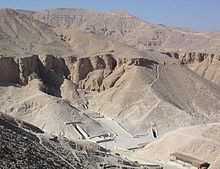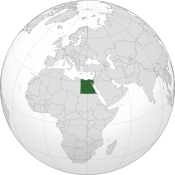Egyptian treasures found in ancient tomb
Friday, March 13, 2009
A team of archaeologists excavating an Ancient Egyptian tomb have discovered golden jewelry in a recently-discovered lower chamber at the Valley of the Kings burial site in Luxor, Egypt.
Two golden rings and five golden earrings were found in the tomb of Djehuty, an 18th-dynasty official of Queen Hatshepsut, and were probably the property of Djehuty or his family.
The discovery was announced by Farouk Hosni, Egypt's current Minister of Culture.

Djehuty was overseer of the treasury and overseer of works for the Queen. Hatshepsut reigned approximately 1479–1458 BCE. Djehuty was responsible for managing the huge amounts of precious goods brought in from Egypt's military expedition to Punt in the Horn of Africa and the vast building projects of Hatshepsut which have made the female pharaoh one of the most-remembered of any from ancient Egypt.
Djehuty died after Hatshepsut did, sometime during the reign of Thutmosis III. Both Hatshepsut's and Thutmosis's names are recorded on the tomb. In a fashion typical of ancient Egyptian rivalries, Hatshepsut's name was partly obscured on the monument over the tomb sometime after the queen's death.
The team, led by José Manuel Galán of the National Research Center (Consejo Superior de Investigaciones Científicas, CSIC), in Madrid, Spain, had been excavating the tomb, designated TT11 and located in the necropolis of Dra' Abu el-Naga', since 2002. While much of Djehuty's funerary equipment was lost to fire in antiquity, the lower chamber of his tomb was concealed at the end of a three-meter shaft and discovered at the end of 2008.
A superficial description of the tomb itself was recorded almost two hundred years ago by 19th-century French Egyptologist Jean-François Champollion, rubble blocking the entrance hindered excavation until the 21st century. In that time, emphasis in Egyptology has changed from the cataloging of treasures to the investigation of ancient culture, life and religion.
Since excavation began, Djehuty's tomb has yielded a number of surprises. It was discovered that the tomb was re-used repeatedly up to and during the Greco-Roman period. There is an unusual face-on depiction of pharaoh Thutmosis III hunting ducks, and the mummy of a young, bejewelled, as-yet unidentified woman.

In 2007, 44 preserved bunches of flowers thought to be from Djehuty's funeral were found in the site. In their 8th season of excavation, which ended on February 22, 2009, the team also found considerable evidence that below Djehuty's tomb is a network of burial sites from the 11th dynasty, four thousand years old.
The lower chamber also displays passages from the Egyptian funerary text the Book of the Dead on its walls and a colorful mural of the goddess Nut, an embodiment of the heavens, on the ceiling. The names of Djehuty and his parents were also intact in the second chamber; the names were defaced in the previously-known first chamber of the tomb, which had also been looted.
According to a press release from Dr. Zahi Hawass, Secretary General of Egypt’s Supreme Council of Antiquities, Djehuty's tomb is only the fifth known decorated burial chamber of the 18th dynasty. An additional unusual feature of the tomb is that its upper chamber is decorated in relief, rather than simply paint. When the excavation is completed, Dr Galán's team plans to open the site to the public as the carved stoneworks will not be destroyed by tourists' activities as paint would.
The identification of Djehuty is a complicated one, as a number of officials of the 18th dynasty bore the name, including a general and several governors. The name itself is an alternate transliteration of the name of the Egyptian god usually written in English as Thoth.
Sources
- "Gold Treasures Found in Ancient Egyptian Tomb" — artinfo.com, March 11, 2009
- "Ancient golden jewelry found in Egyptian tomb" — Associated Press, March 11, 2009
- Mahmoud Kassem. "Ancient Egyptian Gold Found in Luxor by Spanish Archaeologists" — Bloomberg L.P., March 10, 2009
- "Archaeologists Find Ancient Jewelry in Egyptian Tomb" — Voice of America, March 10, 2009
- Press Release: "New Discovery in the Tomb of Djehuty (TT11) at Dra Abu El-Naga" — Zahi Hawass, undated
- José Manuel Galán (editor). "Diario 22/2/2009" — Proyecto Djehuty, February 22, 2009 (Spanish)
- José Manuel Galán (editor). "2008 Campaign Summary, SPANISH-EGYPTIAN MISSION AT DRA ABU EL-NAGA TOMBS OF DJEHUTY AND HERY (TT 11-12)" — Proyecto Djehuty, 7th Season, 2008
- Nevine El-Aref. "Say it with flowers" — Al-Ahram Weekly, April 4, 2007
- Nevine El-Aref. "Thrills at Thebes" — Al-Ahram Weekly, February 20-26, 2003
- Jacinto Antón. "Egiptólogos españoles excavarán en Tebas la tumba del noble Djehuty" — El País, January 27, 2002 (Spanish)



